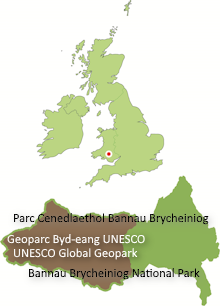South Wales was a major player in a new industrial age which changed the world and the area that is now the Geopark played a significant role in the industrial history of the region. A key product of the area were silica bricks which were used in the copper, iron and steel industries but also exported worldwide and contributed to the industrial development of other nations.
Mining the rock
Early industrialists discovered that certain deposits of more or less pure silica (SiO2) in the area provided ideal ingredients for the manufacture of firebricks for kilns and furnaces. The source of this pure silica is the Basal Grit quartzite which occurs widely across the southern parts of the Geopark.
The Basal Grit quartzite was mined at Craig y Ddinas in the Pontneddfechan area from the late 18th century until 1964. Smaller mines operated in the gorge of the Nedd Fechan too. The firebricks that were manufactured from this rock were exported world wide and the importance of the industry across Europe is well-illustrated by the fact that in Russia firebricks are still called ‘Dinas’.
Quarrying the sand
Silica sand derived from shattered Basal Grit quartzite near Penwyllt in the upper Swansea Valley was extracted and used in the manufacture of refractory fire bricks for the smelting industries. The silica sand was transported from its source at Pwll Byfre via tramroads to a brickworks at Penwyllt. Another source of silica sand was worked at nearby Cribarth whilst towards the western end of the Black Mountain were a number of other such deposits, such as those near Herbert’s Quarry off the Mountain Road north of Brynaman and between Cefn Carn Fadog and Foel Fraith. Each of these occurrences was worked at one time or another.
Moving the materials
Tramroads and railroads from many of these mines and quarries connected with the Swansea Canal which reached inland as far as Glyn-neath and the Neath Canal to Glyn-neath ensuring ready transport to the industrial powerhouses of Swansea and the valleys.
Historians date the start of the Industrial Revolution in Britain at about 1760 when transport, machinery and the generation of power permitted large-scale industrial development. The Brecon Forest Tramroad which connected the Geopark area to the Swansea Canal is important in the history of transport as it was one of the earliest examples of an integrated transport network, being built around 1780 and occupied the phase of rapid evolution between horse-drawn railways and locomotives-hauled lines.



